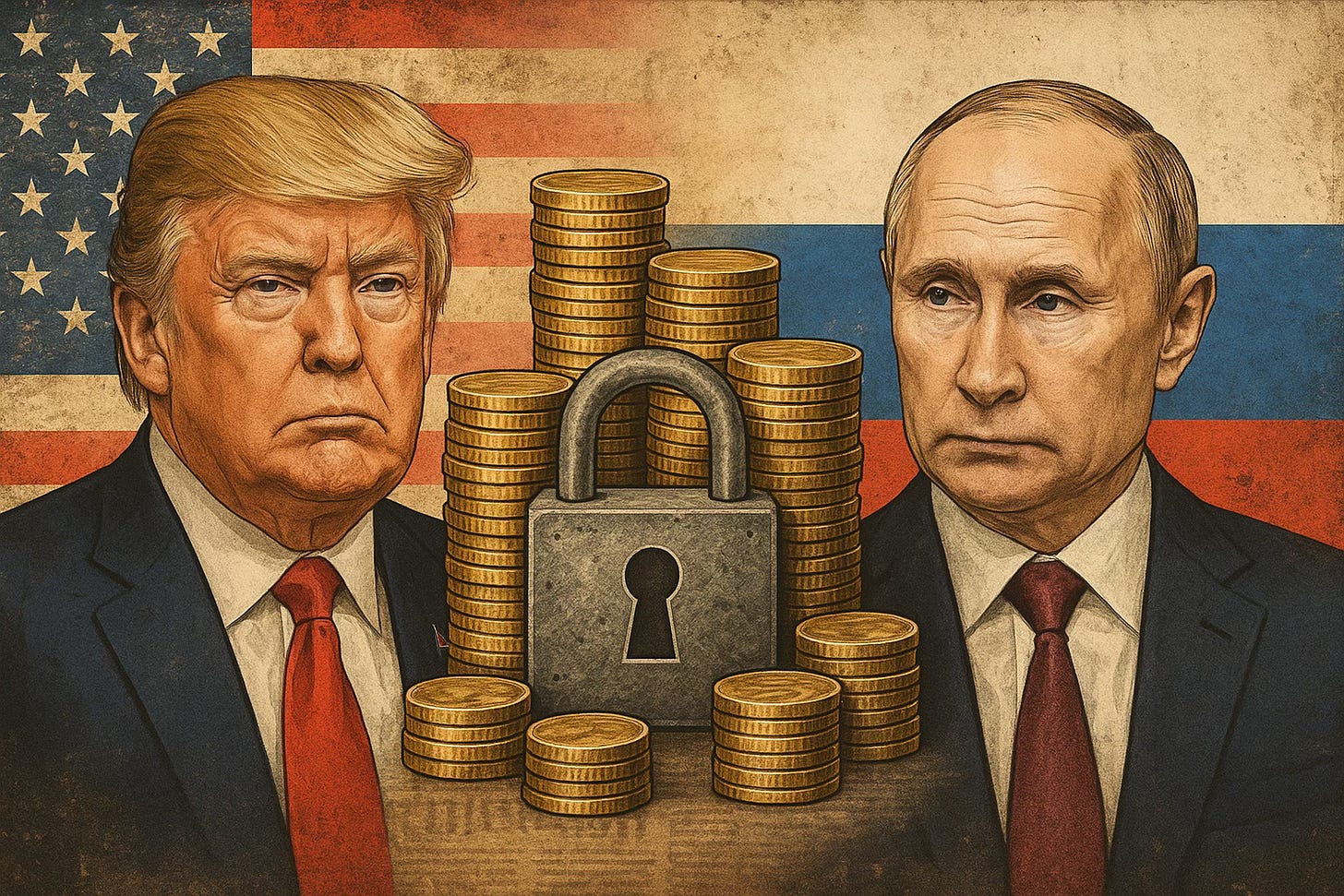Trump, Putin, and the $300 Billion Question
Dismantled watchdogs, secret meetings, and billions in frozen assets suddenly within reach.
Two news items this morning made me sit up.
First: The European Union on Thursday replicated Trump’s new sanctions against the Russian oil industry. While President Vladimir Putin called the move an “unfriendly act” that could backfire by spiking global oil prices, Ukrainian President Volodymyr Zelensky welcomed it as “very important” and long overdue. 1
Second: Kirill Dmitriev, Russia’s top economic envoy and head of Russia’s sovereign wealth fund, the Russian Direct Investment Fund (RDIF), is in Washington and expected to meet Trump’s special envoy, Steve Witkoff, today. GOP Rep. Anna Paulina Luna will also attend the meeting in Miami, Florida, at an undisclosed location. Dmitriev posted on X that the purpose is “to continue discussions about the U.S.–Russia relationship.” 2
So, why is the director of Russia’s sovereign wealth fund here? What is there to discuss? The simplest answer: we should have nothing to do with Russia until Putin agrees to a ceasefire in Ukraine.
Sovereign Wealth Funds in the Hands of Authoritarians
A sovereign wealth fund (SWF) is a state-owned investment vehicle that manages surplus revenues, often from natural resources, trade surpluses, or central-bank reserves, and invests them in stocks, bonds, real estate, and infrastructure.3 In well-governed democracies, SWFs can be legitimate public-interest tools. But in authoritarian countries, where checks and oversight are weak, they often become instruments of corruption. Revenue meant for citizens is diverted to politically connected firms and private interests. That has been the pattern in Russia, Hungary, and other autocratic regimes.
Trump issued an executive order and floated plans for a U.S. SWF, but no such fund has been created or activated as of this writing. 4
It is entirely possible Dmitriev is in the U.S. to negotiate lifting the RDIF sanctions imposed after the 2022 invasion of Ukraine.5 Those sanctions, along with related blocks on RDIF and its manager, were part of a broader effort to cut off revenue streams that could fund Moscow’s war machine. Brookings and other analysts estimate that frozen Russian sovereign assets now total between $300 and $330 billion, although only about $5 billion of that is held in the United States. 6
Can Trump Release Frozen Russian Assets?
Freezing assets is an executive action a president can take under the International Emergency Economic Powers Act (IEEPA).7 But spending, transferring, or permanently reallocating frozen sovereign assets generally requires explicit statutory authority from Congress. Moreover, most of the frozen principal is held in European jurisdictions, so any U.S. action would have to align with EU and G7 rules, which currently limit use to interest earned on the frozen funds—not the principal itself. 8
Trump could theoretically terminate the national emergencies declared in response to Russia’s aggression since 2014, which serve as the legal basis for many sanctions imposed through executive order. However, eliminating international sanctions would require persuading European and G7 partners to unwind their own packages.
The deeper story here isn’t just about one meeting or one Russian fund. It’s about the collapse of oversight that allows these dealings to happen in the dark. Project 2025 has replaced independent watchdogs with loyalists, gutted the inspectors general system, and blurred the line between public power and private enrichment. That institutional decay is what makes authoritarian governance possible: a government that serves itself instead of the people. When laws become optional and secrecy becomes standard, foreign influence is not an accident; it’s an inevitability.
The Trump administration, however, has never treated laws as real constraints. Since the Supreme Court’s 6–3 ruling on June 30 granting substantial presidential immunity, Trump has repeatedly claimed he can ignore legal limits9 With a compliant Republican majority in Congress, the usual checks appear paper-thin. If he tried to release or redirect frozen Russian assets without congressional authorization, the action would almost certainly face legal challenges, but court battles take time, and the political damage would already be done.
Trump said on his Truth Social platform that he discussed “major economic development transactions” with Putin during a February call, while the Kremlin said the two leaders later discussed cooperation “in the economy and energy sector.” 10 Trump clearly sees an economic opportunity in resetting relations between Russia and America—a rapprochement that not long ago would have been unthinkable.
Adam Kinzinger’s Proposal
I’m an admirer of Adam Kinzinger’s work, and his October 21 Substack post presents a compelling plan to pressure Putin financially.11 He proposes using $2 billion a day from Russia’s state assets held in Western banks until Russia ends the war or the fund is exhausted. It’s a bold, pragmatic idea that deserves serious consideration and public debate.
What Can We Do?
If Dmitriev’s visit aims to loosen RDIF’s restrictions, Americans should demand transparency. What is being negotiated? What legal authority would be used? How would any transfer of funds be coordinated with allies? We must not trade away moral clarity, legal safeguards, or Ukrainian lives for opaque deals made behind closed doors.
Reporters: get the visitor logs, meeting itineraries, and any drafts of proposed agreements.
Citizens: contact your representatives and ask what authority they would grant the executive.
Share this Substack on your social media and with friends and family. Awareness is our first line of defense.
“What is a Sovereign Wealth Fund, and how do counties utilize them?,” Finance Dispatch, Jul. 20, 2025


